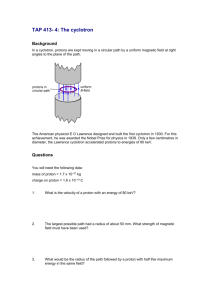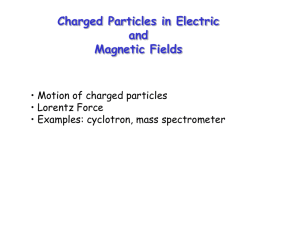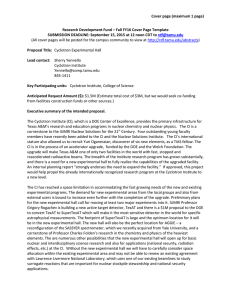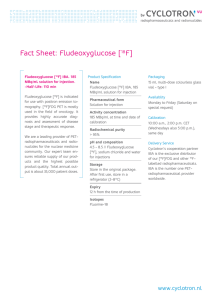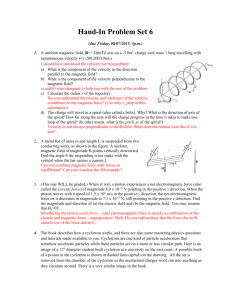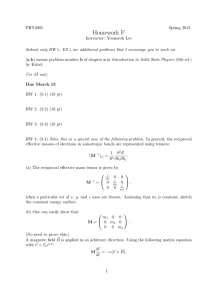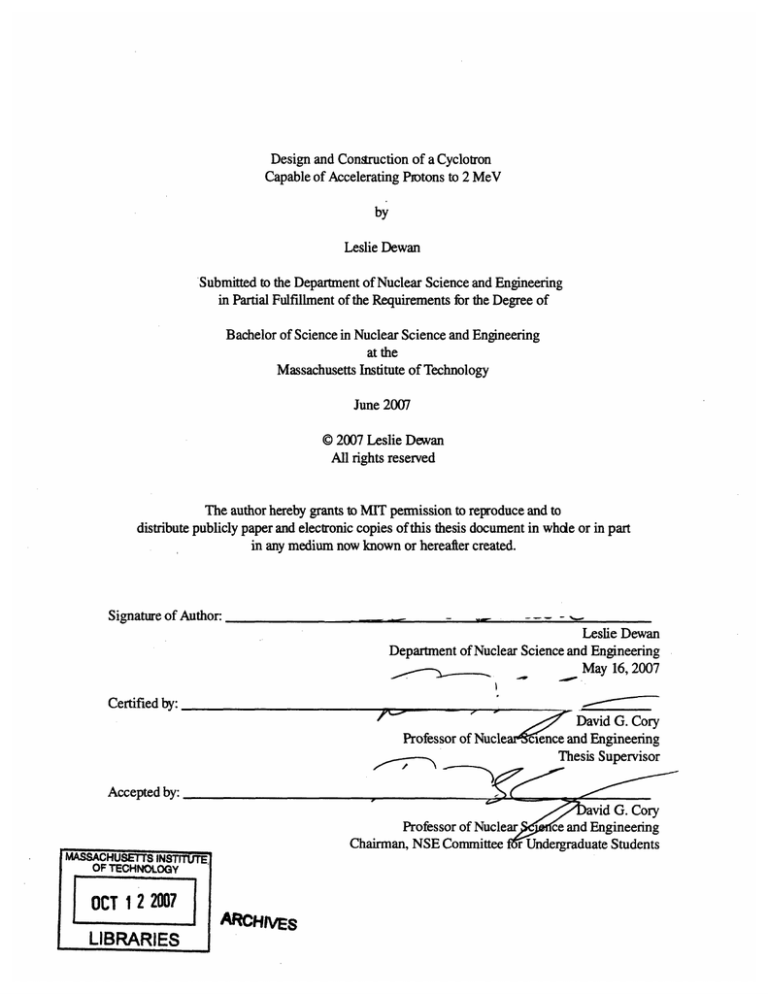
Design and Construction of a Cyclotron
Capable of Accelerating Protons to 2 MeV
by
Leslie Dewan
Submitted to the Department of Nuclear Science and Engineering
in Partial Fulfillment of the Requirements for the Degree of
Bachelor of Science in Nuclear Science and Engineering
at the
Massachusetts Institute of Technology
June 2007
© 2007 Leslie Dewan
All rights reserved
The author hereby grants to MIT permission to reproduce and to
distribute publicly paper and electronic copies of this thesis document in whole or in part
in any medium now known or hereafter created.
Signature of Author:
,
.
Leslie Dewan
Department of Nuclear Science and Engineering
May 16, 2007
Certified by:
-.- -
~
Professor of Nucle
f
/·-
Accepted by:
LIBRARIES
,
--
---
avid G. Cory
Professor of Nuclear
ce and Engineering
Chairman, NSE Committee f Undergraduate Students
MASSACHUSETTS INSTITUTE
OF TECHNOLOGY
OCT 12 2007
David G. Cory
ience and Engineering
Thesis Supervisor
ARHIVES
Design and Construction of a Cyclotron
Capable of Accelerating Protons to 2 MeV
by
Leslie Dewan
Submitted to the Department of Nuclear Science and Engineering on May 16, 2007
in Partial Fulfillment of the Requirements for the Degree of
Bachelor of Science in Nuclear Science and Engineering
ABSTRACT
This thesis describes the design and construction of a cyclotron capable of accelerating protons to
2 MeV. A cyclotron is a charged particle accelerator that uses a magnetic field to confine particles
to a spiral flight path in a vacuum chamber. An applied electrical field accelerates these particles
to high energies, typically on the order of mega-electron volts. This cyclotron can be used by
students in the Department of Nuclear Engineering to perform experiments with low energy proton
beams. For example, this cyclotron could be used for experiments involving the Li7(p,n)Be7
reaction, which requires protons with energies on the order of 2 MeV [2].
Thesis Supervisor: David G. Cory
Title: Professor of Nuclear Science and Engineering
22 Thesis
Cyclotron Design and Construction
Contents
Table of Figures..........................................................................
Introduction.....................................
......................................
4
.................................................................................. 5
Thesis Objectives.......................................................
.......................................................
Preliminary Research and Analysis.................................................................................
6
7
Vacuum Chamber............................................................................................................. 9
Determining Required Vacuum Pressure..........................................9
Testing Vacuum Chamber........................................................................................ 11
Vacuum Chamber Ports.......................................... .............................................. 11
Details of Design and Construction......................................... 12
Electrodes......................................................................................
.................................... 13
Principles of Operation................................................... ...................................... 13
Details of Design and Construction.......................................... 14
RF System........................................................................................
.................................
Principles of Operation.......................................... ...............................................
Tuning and Testing the RF System.............................. . ....... .
........
Details of Design and Construction...........................................
14
14
15
16
Proton Source.....................................................................................
................................ 17
Principles of Operation................................................... ....................................... 17
Details of Design and Construction..........................................................................18
Proton Detector...................................................................................
............................... 19
Principles of Operation.......................................... ............................................... 19
Details of Design and Construction......................................................................... 19
Conclusions and Additional Testing....................................................................................
20
References..............................................................................
21
....................................
Appendix A: MATLAB code to calculate particle mean free path................................
Leslie Dewan
3 of 23
22
5/16/07
22 Thesis
Cyclotron Design and Construction
List of Figures
Figure 1. Cyclotron built by Earnest Lawrence and Stanley Livingston in 1931.
Figure 2. Schematic showing particles' flight path in a cyclotron, as well as the applied magnetic
and electric fields.
Figure 3. Magnetic field intensity as a function of gap distance for a Varian V-3900 magnet (from
Varian Analytical Instrument Division V-3900 manual).
Figure 4. Yields from the proton bombardment of lithium. The uppermost curve represents
relative neutron yields. The threshold of the Li7(p,n)Be7 reaction is at 1.882 MeV. (from Bair
1952).
Figure 5. Proton mean free path in meters versus vacuum pressure in Torr.
Figure 6. Vacuum chamber and numbered ports, connecting to the following subsystems: (1) RF
system; (2) vacuum pump to maintain low pressure in the chamber; (3) filament leads for the ion
source; (4) a hydrogen supply for the ion source; and (5) a target to collect the accelerated particles.
Figure 7. Copper electrodes and connection to RF system, with copper grounding strap to ensure
consistent connection to ground.
Figure 8. Schematic of resonator and tuning capacitor.
Figure 9. Schematic plot of energy versus frequency for a damped oscillator. Q is defined as Af/fo0.
Figure 10. Cyclotron RF system in aluminum box with copper grounding straps.
Figure 11. Ion source schematic, indicating election flow.
Figure 12. Cyclotron ion source, showing wires connecting to neodymium wire filament and
hydrogen inlet tube.
Figure 13. Proton detector and copper flashing which ensures constant connection to ground and
shields detector.
Figure 14. Closed cyclotron chamber, RF box, and mounting plates.
Leslie Dewan
4 of 23
5/16/07
22 Thesis
Cyclotron Design and Construction
Introduction
A cyclotron is a charged particle accelerator that uses a magnetic field to confine particles
to a spiral flight path in a vacuum chamber. An applied electrical field accelerates these particles
to high energies, typically on the order of mega-electron volts. Figure 1 shows the vacuum
chamber and electrodes of an early cyclotron, built by Ernest Lawrence and Stanley Livingston in
1931.
A particle in a cyclotron encounters the same accelerating electric field many times along
its spiral flight path. This flight path is shown schematically in Figure 2. Using the accelerating
field in this fashion allows a cyclotron to produce high-energy particles far more efficiently than
other accelerators, such as linear accelerators.
Top View
Uniform magnetic L
* *
El~
field
+b =etric
ekacric
' ",
' "'
.
anclied
botwec
"'.
'
"
,-..
* ,
thl
-
j
-
U
UI
rej
B
,r
Output beam of high f
velocity electrons. r
Figui
and
S. Livingston in 1931. (from the National
Museum of Science and Industry, UK)
Leslie Dewan
Figure 2. Schematic showing particles' flight
path in a cyclotron, as well as the applied
magnetic and electric fields. (from
Georgia State University)
5 of 23
5/16/07
22 Thesis
Cyclotron Design and Construction
The force of the magnetic field on the charged particles is described by the following
relation:
my
F =qvB-V
(1)
r
where B is the magnetic field in Tesla, r is the particle's radius in meters, m is the particle's mass in
kg, and q is the particle's charge in Coulombs. This equation can be rearranged to give the
particle's velocity as a function of the other variables:
v= Br
(2)
m
This velocity can be used to derive the angular frequency of the particle's flight path.
v _ qBr 1 _ qB
f2rrr m 2rrr 2rrm
(3)
The signal applied to the cyclotron's electrodes must oscillate at this frequency. The particles'
maximum kinetic energy can also be determined from equation 2:
1 mv 2 lmq 2 B 2r2 q 2B2r2
KE=--
2 r
-
2
m
2
(4a)
2m
As shown in equation 4a, the particles' maximum energy depends on the strength of the
magnetic field. A larger magnetic field exerts a greater centripetal force on the particles (by
equation 1), making their flight path a tighter spiral. A particle traveling along this tighter spiral
encounters the electrical field more often, and is therefore accelerated to a greater velocity and
kinetic energy.
Thesis Objectives
The purpose of this thesis is to design and construct a cyclotron capable of accelerating
protons to 2 MeV. This cyclotron can be used by students in the Department of Nuclear
Engineering to perform experiments with low energy proton beams. For example, this cyclotron
could be used for experiments involving the Li6(p,n)Be7 reaction, which requires protons with
energies on the order of 2 MeV [2].
Leslie Dewan
6 of 23
5/16/07
22 Thesis
Cyclotron Design and Construction
Preliminary Analysis and Research
Some preliminary analysis was necessary before starting to design the cyclotron's
components. Specifically, this analysis determined the type of charged particles to accelerate and
the range of energies to which these particles could be accelerated. The particles' maximum
energy determines the types of reactions they can undergo.
There are certain difficulties inherent in accelerating elections to high velocities. Electrons
are approximately 1800 times less massive than protons. By equation 2, a system with a given
magnetic field strength and radius would be able to accelerate electrons to velocities 1800 times
greater than the maximum proton velocity, neglecting relativistic effects. Charged particles
moving along a curved flight path at high velocities emit high-energy photons, which must be
shielded. In this cyclotron, which has a maximum magnetic field strength of approximately 2.5
Tesla and radius of approximately 8 cm, protons are not able to reach a high enough velocity to
emit this radiation. However, accelerated electrons would emit photons with energies in the x-ray
range. It was decided to accelerate protons in this cyclotron because the system would not require
extensive shielding. It is also straightforward to generate protons by ionizing hydrogen.
As shown in equations 1,2, and 3, and 4a the protons' maximum attainable energy is
limited by the dimensions of the magnet's poles and ils maximum field strength. The magnetic
field strength is a function of the separation distance between the north and south poles of the
electromagnet. This cyclotron's magnetic field is produced using a Varian V-3900 magnet. Figure
3 shows the relation between gap distance and magnetic field intensity for this magnet.
Leslie Dewan
7 of 23
5/16/07
Cyclotron Design and Construction
22 Thesis
76
0
A/IR GAP -. CENTIMETERS
la
20 25
L3 i 5
AIR GAP -
5
VNCHES
Figure 3. Magnetic field intensity as a function of gap distance for a Varian V-3900 magnet (from
Varian Analytical Instrument Division V-3900 manual).
As shown in Figure 3, the magnet generates 2.7 T of magnetic field with a 1.25 inch pole
separation. By equations 4b and 5, protons accelerated through a vacuum while contained in this
magnetic field can attain a maximum energy of approximately 2 MeV.
KE
1 mv 2
2 r
1 mq2 2r2 q2 B2r 2 (1.6-10-19)2 (2.7)2(0.075)2
2m
2
2.1.67-10-27
m2
-
43 1 1MeV
3.14310-13J
1.6-10-13j
-
= 3.143E-13 J
= 1.96 MeV
(4b)
(5)
This maximum proton energy determines the reactions that the protons could undergo with a
target. These protons have a sufficiently high kinetic energy to undergo the Li7(p,n)Be7 reaction.
As shown in Figure 4, this reaction requires particles with energies of at least 1.882 MeV.
Leslie Dewan
8 of 23
5/16/07
22 Thesis
Cyclotron Design and Construction
I
PROTON ENERGY IN MEV
Figure 4. Yields from the proton bombardment of lithium. The uppermost curve represents
relative neutron yields. The threshold of the Li7(p,n)Be7 reaction is at 1.882 MeV. (Bair 1952)
It is possible to accelerate protons to this energy with the existing pole pieces in place. The
existing pole pieces have an 8 cm radius and a separation gap of 1.25 inches. By equations (4b) and
(5), this geometry and field strength is capable of accelerating protons to a maximum kinetic energy
of 1.96 MeV. It is possible to acquire lower energy particles by positioning the detector at a smaller
radius. A detector positioned 7.34 centimeters from the center of the accelerator will intercept
particles with energies of approximately 1.88 MeV in the presence of a 2.7 T magnetic field.
The presence of this strong magnetic field means that all cyclotron components must be
made of magnetically transparent materials such as aluminum, copper, or brass. The magnetic
field would cause oscillations, which would disrupt measurements, in materials such as steel that
are not magnetically transparent.
Vacuum Chamber
DeterminingRequired Vacuum Pressure
The MATLAB simulation shown in Appendix A calculates the protons' flight distance as a
function of the magnetic field strength. It also plots the protons' mean free path as a function of the
vacuum pressure inside the chamber. The mean free path of a particle is the average distance a
Leslie Dewan
9 of 23
5/16/07
Cyclotron Design and Construction
22 Thesis
particle travels between collisions. For a particle moving at a high velocity compared to a set of
target particles, the mean free path is given by equation 6.
/=(no-)-
(6)
where 1is the mean free path, n is the number of particles per unit volume, and sigma is the target
particles' cross-sectional area. The number of particles per unit volume depends on the pressure
inside the vacuum chamber by the ideal gas law.
P
n
kT
=(7)
where P is the pressure in Pascals, T is the temperature in Kelvin, and k is Boltzmann's constant,
which is equal to 1.38066 x 10-23 J/K.
An acceptable vacuum would allow for a mean free path an order of magnitude larger than
the expected flight distance. For protons accelerated by a 2.7 T magnetic field and a voltage
difference of 1000 V between the electrodes, the expected flight distance is approximately 300
meters. Figure 5 is a graph of the particle's mean free path versus the degree of vacuum, in Torr, in
which they are traveling.
Roton
MemFreeP,
10
-·-·-·-·
-----
·-- ·
Presue
sm
-·---·---
-
------
··
---- · ·- ·--
10
E 10
i
I-
·r
10
10
In
.
.
'
"""I
. -. .
-
10
.
'
.
.- ..
.
"
""""
-4
-
10
10
.
-.
.
,--- ,
,--,.
,,
,---.
"
....
***"
-2
10
Trr
Presore,
1
10
0
10
Figure 5. Proton mean free path in meters versus vacuum pressure in Torr.
Leslie Dewan
10 of 23
5/16/07
22 Thesis
Cyclotron Design and Construction
Testing the Vacuum Chamber
The vacuum chamber was pumped using a Varian Turbo-V 70 vacuum pump. The vacuum
chamber can be consistently pumped down to approximately 2*10-3 Torr. According to Figure 5,
this corresponds to a mean free path of 5 kilometers, which is approximately an order of magnitude
longer than the protons' expected path length.
Vacuum ChamberPorts
The vacuum chamber contains the two copper electrodes used to accelerate the protons, and
an ion source. This chamber has a series of ports, which connect it to (1) a signal generator and RF
matching box; (2) a vacuum pump that maintains low pressure in the chamber; (3) filament leads
for the ion source; (4) a hydrogen supply for the ion source; and (5) a target to collect the
accelerated particles. Figure 6 shows the position of these five ports on the vacuum chamber.
Figure 6. Vacuum chamber and numbered ports, connecting to the following subsystems: (1) RF
system; (2) vacuum pump to maintain low pressure in the chamber; (3) filament leads fir the ion
source; (4) a hydrogen supply for the ion source; and (5)a target to collect the accelerated particles.
Leslie Dewan
11 of 23
5/16/07
Cyclotron Design and Construction
22 Thesis
Details of Design and Construction
The sides of the vacuum chamber are made of 6061 aluminum. The vacuum chamber lids
are made of 7075 aluminum, because that alloy has a significantly larger tensile strength and yield
strength than 6061 aluminum, as shown in Table 2.
Table 2. Properties of Aluminum Alloys (from Machinery's Handbook).
Alloy
Young's Modulus (GPa)
Yield Strength (MPa)
6061-T6
69
.275
7075-T6
75
505
The chamber lids are subject to significant stresses because of the low pressure inside the
chamber. Following equation 8, which describes the deflection of a circular plate under uniform
load with a fixed support around the entire outer boundary, a lid with radius 10 centimeters and
thickness of 3.5 millimeters would undergo less than 1 mm of deflection when covering a chamber
with internal pressure of 103 Torr. These calculations were also verified experimentally-pumping
the chamber to vacuum resulted in no visible lid deflection.
center =
D=
2D
(8a)
(L4-Ll1)
Et33
Et
12(1-v
(8b)
2)
4
( 2
L=
64
2
2
(1+4() -5()
-4()
(2+(r) )ln(a))
a
a
a
a
ro
1
ro
ro 2
L14= -(1-(-)
-4(
))ln()
16
a
a
ro
(8c)
(8d)
In equation 8, a is the plate radius in meters, ro is the outermost radius at which the distributed load
is applied q is the linearized load in Newtons per meter, t is the plate thickness in millimeters, E is
the modulus of elasticity and v is the Poisson ratio.
Leslie Dewan
12 of 23
5/16/07
22 Thesis
Cyclotron Design and Construction
The chamber has two grooves for Viton o-rings, which make the connection between the
side and lids vacuum-tight. The chamber's ports were made by screwing lengths of pipe, which
were sealed with Teflon tape, into tapped holes in the side of the chamber. The other ends of the
pipes were screwed onto QF flanges.
Electrodes
Principlesof operation
Smaller cyclotrons often accelerate particles using two dee-shaped electrodes. Figure 1
shows an example of this design. This cyclotron uses an alternative design: it has one dee-shaped
copper electrode, and the grounded vacuum chamber functions as the other electrode. Figure 7
shows the shape and positioning of the electrode with respect to the vacuum chamber.
F
consistent connection to ground.
P system, witn copper grouncang strap to ensure
Leslie Dewan
13 of 23
5/16/07
22 Thesis
Cyclotron Design and Construction
Details of Construction
The dee-shaped electrode was made by first cutting pieces of copper on an OMAX waterjet
machine, then soldering the pieces together. A length of copper rod was then soldered to the dee.
The copper rod was threaded at one end to make an electrical connection with an RF feedthrough
(Varian Vacuum, part number 9545143). The feedthrough connects to the RF control box, as
shown in Figure 7.
RF system
Principlesof Design
The RF system ensures that the cyclotron's impedance is matched with the incoming signal
impedance, which is 50 Ohms. An impedance mismatch would cause a fraction of the incident
power to be reflected, making the system less efficient. The cyclotron electrodes and vacuum
chamber act as a capacitor. This capacitor in parallel with an inductor resonates at a particular
frequency, given by equation 9.
f
I
2=rv
(9)
Placing an additional variable capacitor in series with the system makes it possible to tune the
system's impedance to 50 Ohms. Figure 8 is a circuit diagram of the resonator and tuning
capacitor.
Figure 8. Schematic of resonator and tuning capacitor.
Leslie Dewan
14 of 23
5/16/07
22 Thesis
Cyclotron Design and Construction
Tuning and testing the RF system
First, the capacitance in vacuum chamber was determined by placing a coil with an
arbitrary inductance in series with the cyclotron chamber, and measuring the resonant frequency
with the network analyzer. Next, the same arbitrary inductor was placed in series with a 100 pF
capacitor, and the resonant frequency was again measured. After performing this measurement,
the coil's inductance could be determined using the resonant frequency, the known capacitance,
and equation 9. Once the coil's inductance was known, the chamber's capacitance was determined
using equation 9. The vacuum chamber's capacitance is 92 pF
After determining the chamber's capacitance, a copper inductor coil and variable resistor
were added to the circuit. The inductor and cyclotron chamber resonated at 15.1 MHz. The
variable capacitor was tuned so that the circuit had an impedance of 50 Ohms. Once the circuit
was tuned, it was tested for arcing with 100 W pulses. During testing, the chamber was connected
to an oscilloscope that displayed the incident and reflected signal. A chamber that is not arcing
produces a signal that is invariant in time. The chamber did not arc during the 100 W pulses.
A circuit's quality factor (Q) is a dimensionless number representing the ratio of the total
energy stored in an oscillating system to the energy lost in a single cycle. Q can be represented
schematically on a graph of current versus frequency, as shown in Figure 9. Q is defined as the
resonant frequency (f0) of the system divided by the bandwidth (Af).
E max
energy of
steady-state
vibrations
E
max
2
frequency
Figure 9. Schematic plot of energy versus frequency for a damped oscillator. Q is defined as fo/Af.
(B. Crowell).
Leslie Dewan
15 of 23
5/16/07
22 Thesis
Cyclotron Design and Construction
Before constructing the cyclotron chamber and electrodes, the Q factor was estimated, using
approximations for the system's capacitance and resistance. This estimate is shown in equation 10.
Q=R
1
1
Q=
Q 8.6-10-1_
, where R = 4 mOhms
(10a)
-9
(10b)
190.1(
190-10-9- 9 =185
7510
1
A more precise value of the Q factor was determined after the chamber and electrodes were
built by measuring the bandwidth and resonant frequency of the oscillator. For a resonant
frequency of 15 MHz and bandwidth of 80 KHz, Q is equal to 190. This experimentally derived
result is gratifyingly similar to the predicted outcome.
Detailsof Construction
The RF components, shown in Figure 10, are housed in an aluminum box made of bent
sheet aluminum. An n-type bulkhead connector mounted directly to the box connects to the
function generator and power amplifier that generate the RF signal. The variable capacitor is
mounted to the box using Delrin standoffs to prevent arcing. The box also contains a copper
inductor coil made of 8 gauge copper wire. The components in the box are connected by 10 gauge
copper wire. A copper grounding strap ensured a good electrical connection between the RF
source's ground, the RF box, and the vacuum chamber.
Leslie Dewan
16 of 23
5/16/07
22 Thesis
Cyclotron Design and Construction
Figure 10. Cyclotron RF system in aluminum box with copper grounding strap.
Proton Source
Principlesof Operation
The cyclotron's ion source uses electrons to ionize hydrogen gas, thereby generating
protons. The electrons are generated by thermionic emission. Thermionic emission occurs when
electrons on the surface of a hot conductor (on the order of 1000 - 3000K) have enough kinetic
energy to overcome the electrostatic forces binding them to the surface. In this cyclotron's ion
source, the electrons flow from a negatively biased neodymium filament to the chamber ground.
Figure 11 is a circuit diagram showing the flow of electrons in the ion source. These electrons have
sufficient energy to ionize hydrogen gas to form protons.
Leslie Dewan
17 of 23
5/16/07
22 Thesis
Cyclotron Design and Construction
Figure 11. Ion source schematic, indicating election flow.
rigure zL.t.yclotron ion source, snowing wires connecting
hydrogen inlet tube.
Io
neodymium wire filament and
Details of Construction
Figure 12 shows the completed ion source. The filament is made ofneodymium wire,
which is connected to a vacuum-tight feedthrough (Kurt J. Lesker, part number EFT0024038).
There are 22 Ohms of resistance across the feedthrough leads. The filament temperature must be
approximately 1000 K for thermionic emission to occur. The wire achieves this temperature when
approximately 10 volts are applied across the filament.
Leslie Dewan
18 of 23
5/16/07
22 Thesis
Cyclotron Design and Construction
Proton Detector
Principlesof Operation
The protons were detected at the end of their flight path using a Faraday cup. A copper rod,
which was connected to ground through an amplifier (Stanford Research Systems SRS560) was
positioned 7.34 cm from the center of the cyclotron chamber. Protons incident upon the copper rod
generate a current. The copper rod is shielded with copper flashing to reduce measurement noise.
There are also negative ions in the chamber produced when the hydrogen gas is ionized.
These negative ions travel in an opposite direction to the positive protons. If these negative ions
strike the copper rod, they will neutralize the protons' signal. Therefore, the copper rod is shielded
by a piece of aluminum connected to the chamber ground. Negative particles strike this grounded
aluminum, and therefore do not affect the measurement. Figure 13 shows the cyclotron's proton
detector.
Figure 13. Proton detector and copper flashing which ensures constant connection Ioground and
shields detector.
Details of Construction
The detector has a vacuum-tight feedthrough made by press-fitting the copper detector rod
through a piece of Delrin, which was in turn press-fit through a length of copper tubing. The
copper rod is shielding with copper flashing and an aluminum housing box. A BNC connector,
which connects to the amplifier, is mounted to the aluminum housing.
Leslie Dewan
19 of 23
5/16/07
22 Thesis
Cyclotron Design and Construction
Conclusions and Additional Testing
Figure 14 shows the closed cyclotron chamber, RF box, and mounting plates. I was unable
to test the cyclotron's proton source and detector before writing this document, because there was
no hydrogen available for the ion source. These components will be tested during the week of May
27, 2007. The modules of the cyclotron that have been tested-the RF system and vacuum
chamber-all function successfuly. The vacuum chamber can consistently hold a vacuum of
approximately 2*10-3 Torr. The RF system, which has a quality factor of 190, does not arc when
subjected to 100 W pulses. Following testing of the remaining two modules, the cyclotron's
inductor will be tuned to 160 nH (by equation 9), creating aresonance at 41.2 Mhz (by equation 3).
The variable capacitor will then be adjusted to match the incoming signal impedance, and the
applied magnetic field will be set to 2.7 Tesla. Adjusting these parameters will make the system
capable of producing a beam of 1.88 MeV protons, which will drive the Li7(p, n)Be7 reaction.
Figure 14. Closed cyclotron chamber, RF box, and mounting plates.
Leslie Dewan
20 of 23
5/16/07
22 Thesis
Cyclotron Design and Construction
References
[1] Bair, J. "Proton Bombardment of Lithium." Physical Review. 1952.
[2] Bashkin, S. "Proton Bombardment of Lithium Isotopes." Physical Review. 1951.
[3] Bodansky, D. "Neutron Energy Distribution in Proton Bombardment of Beryllium." Physical
Review. 1950.
[4] Clegg, A. "Gamma Radiation fDm the Medium Energy Proton Bombardment of Lithium,
Beryllium, Boron, Carbon, and Nitrogen." Proceedings of the Physical Society. 1961.
[5] Hahn, T. "Neutrons and Gamma Rays from the Proton Bombardment of Beryllium." Physical
Review. 1952.
[6] Oppenheimer, JR and JS Schwinger. "On Pair Emission in the Proton Bombardment of
Fluorine." Physical Review. 1939.
[7] Lawrence, E, and M Livingston. The Production of High Speed Ions Without the Use of High
Voltages. 1932.
[8] Livingston, M. Particle Accelerators. Cambridge, Massachusetts: Harvard University Press,
1969.
[9] Machinery's Handbook, 27th Edition. Eds: R Oberg, J Jones, K Horton, R Ryffel, S
McCauley, D Heald and O Hussain. New York, New York: Industrial Press, 2004.
[10] Rosenblatt, J. Particle Acceleration. Methuen, 1968.
[11] Rutgers Cyclotron. http://www.physics.rutgers.edu/cyclotron/. Created March 2003, Viewed
September 2006.
[12] Scharf, W. Particle Accelerators and Their Uses Amsterdam: Harwood Academic Publishers,
1986.
[13] Wilson, R., and R Littauer, Accelerators: Machines of Nuclear Physics. New York, New York:
Doubleday, 1960.
[14] Young, W, and R Budynas. Roark's Formulas for Stress and Strain, Seventh Edition. New
York, New York: McGraw-Hill, 2002.
Leslie Dewan
21 of 23
5/16/07
Cyclotron Design and Construction
22 Thesis
Appendix A: Proton Flight Path and Mean Free Path Calculations
function cyclotron_and_mfp
m = 1.67*10^-27; % mass of proton, kg
q = 1.662*10^-19; % proton charge, C
r_max = 6.076; % maximum proton flight path radius, m
B = 2.5; % magnetic field strength, Tesla
volts = 50; % applied voltage, volts
freq = q*B/(2*pi*m); %cyclotron frequency, Hz
r = 0; % initial proton flight path radius
t = 0; %initializing time variable
i = 1; %6initializing index i
deltat = 10^-7; % time increment, s
while r < r_max % while the proton's flight path radius is less than the dee's
radius
dEdt = 2*volts*q*freq; % rate of energy input into the cyclotron.
KE = t.*dEdt; % kinetic energy of the proton.
% st time = 0, the proton's kinetic energy is O. All kinetic energy
% increase is due to the applied voltage between the dee and dummy dee.
v = sqrt(2*KE/m); % proton velocity, which is a function of its KE
r = m*v/(q*B);
% the radius of the proton's flight path is a function of it's KE, and
% is therefore a function of its velocity
t = t + deltat; % increment time
% store the following in vectors, to be read later:
time(i) = t;
kineticenergy(i) = KE/(1.6*10^-13);
velocity(i) = v;
radius(i) = r;
flightdistance(i) = v*delta_t;
i = i+1; %increment index
end
KE_max = max(kineticenergy)
totalflight = sum(flightdistance) %determine the proton's total flight path
%plot(time,velocity,'*')
Leslie Dewan
22 of 23
5/16/07
22 Thesis
Cyclotron Design and Construction
%ts = timeseries
x = radius.*sin(2*pi.*time*freq);
y = radius.*cos(2*pi.*time*freq);
%plot(x,y,'.')
%estimating mean free path
rproton = .8*10^-15;
^r_oxygen = 2*60*10"
12;
r_nitrogen = 150*10^-12;
r ave = 10^ -12;
P = [0.001 0.01 0.1 1 10 100]; %pressure, Pa
RB = 8.31; %universal gas constant
T = 300; %temperature in Kelvin
NA = 6.022*10^23;
molardensity = P/(RB*T);
moleculardensity = NA*molardensity;
mfp = 1./(pi*r_ave^2*moleculardensity)
pascal_to_torr = 0.0075
x = 0.0001:0.001:10;
loglog(P*pascal_to_torr, mfp, x, 7*10^3)
title('Proton Mean Free Path vs Vacuum Pressure')
xlabel( 'Pressure, Torr')
ylabel('Mean Free Path, m')
%flight to mfp ratio = totalflight/mfp
Leslie Dewan
23 of 23
5/16/07

